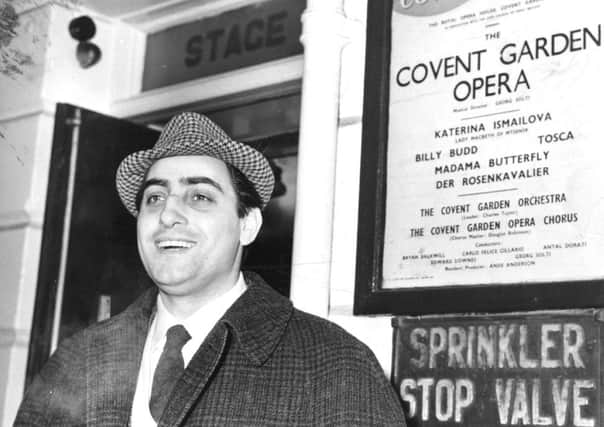Obituary: Renato Cioni, tenor


Although Renato Cioni had made his debut at La Scala in 1961 he sprung to international fame when the Royal Opera cast him as Cavaradossi in the historic new production of Tosca with Maria Callas and Tito Gobbi in 1964.
Franco Zeffirelli’s dramatic production provided a handsome framework for the three great artists and remained popular with audiences and artists for half a century.
Advertisement
Hide AdAdvertisement
Hide AdCioni’s family were farmers on Elba but his musical talents were recognised early and he studied music at the Cherubini Conservatory in Florence. He made successful appearances at Italian houses and was establishing a good career.
Cioni had a fine voice, a handsome appearance – broad and winning smile – but was not well known in the UK. He had made his Covent Garden debut singing the Duke of Mantua in a revival of Rigoletto in 1962. But the Tosca brought him an international reputation and soon he was being booked to sing the great Italian roles in the leading opera houses of the world.
The year before Tosca, Cioni was a member of an exceptionally star-studded company from Teatro di San Carlo, Naples, which filled the King’s Theatre at the Edinburgh Festival. Unfortunately, it witnessed a bruising encounter which hit the headlines for all the wrong reasons: indeed Festival regulars dubbed the incident “The punch up at the Kings”.
Cioni sang Rodolfo in Verdi’s Luisa Miller alongside the baritone Piero Cappuccilli and bass Paolo Washington. The first night became an international scandal.
There was thunderous applause after the first act and Cioni, who had just sung an aria superbly, thought (with reason) that the applause was for him. Washington felt he should have been ushered in front of the curtains to share the ovation. Cioni disagreed and accused him of jealousy. Washington was incensed and let fly with a right hook, while Cappuccilli bravely tried to separate the singers. Cioni was left to struggle through the last act with a bleeding nose.
Cioini’s second visit to the Festival was less controversial. He returned with the Teatro Comunale, Florence, with another wonderful list of artists in 1969.
The visit had been fraught with financial and administrative problems – the company were keen to come to Edinburgh and ultimately contributed to the funding of the visit. Cioni sang the Duke in Rigoletto with Renata Scotto as Gilda and the title role was sung by Mario Zanasi.
But it was the Tosca that made him a star. The rehearsals were somewhat fraught as the diva was not well and she and Gobbi rehearsed much of act two in The Savoy.
Advertisement
Hide AdAdvertisement
Hide AdCioni, however, delivered wonderful performances and was never overawed by the company in which he found himself.
Sir John Tooley, the general administrator of Covent Garden, recognised that to cast a relatively unknown opposite two great stars was a risk.
“We need not have worried,” he recalled later. “Maria warmed to him, and went out of her way to help him come to terms with the challenge.”
He thrillingly delivered Vittoria! in act two and sang E lucevan le stelle with heroic ease.
His contribution is now part of Royal Opera legend and act two has been preserved for posterity on a live video filmed for ITV’s Golden Hour.
Cioni returned for several revivals of the opera and his last appearance as Cavaradossi at Covent Garden was with Marie Collier as Tosca and Gabriel Bacquier as Scarpia. It was splendidly conducted by Alexander Gibson.
Cioni returned to the Royal Opera in 1967 for the production by Luchino Visconti of La Traviata. His colleagues included Mirella Freni and Piero Cappuccilli and the conductor was Carlo Maria Giulini.
His other legendary appearance was as Alfredo in La Traviata under Herbert von Karajan in 1964 at La Scala with Anna Moffo as Violetta which was recorded. He also joined Joan Sutherland in the studio for acclaimed discs of Lucia di Lammermoor (under John Pritchard) and Rigoletto.
Advertisement
Hide AdAdvertisement
Hide AdIn 1970 he made his debut at The Metropolitan Opera House, New York, as Pollione opposite Sutherland and Marilyn Horne under Richard Bonynge. Apart from discs with Callas, Cioni joined Moffo to record Madam Butterfly.
One of Cioni’s favourite memories was singing with Sutherland in Bellini’s Beatrice di Tenda in Naples, The diva’s petticoat slowly slipped down until it was around her ankles. Cioni, with typical Italian bravado, took it in his hands and waved it in the air like a trophy. The Neapolitan audience went wild.
Cioni confined much of the latter part of his career to performances in Italy and teaching.
He returned to live on his beloved Elba.
Cioni is survived by his wife Loretta and their four children.
Alasdair Steven